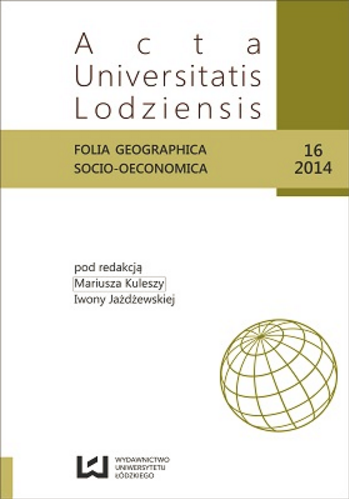Wielkość i kształt działek gruntowych w Łodzi
The size and the shape of ground plots in Łódź
Author(s): Jerzy Dzieciuchowicz, Karolina Dmochowska-DudekSubject(s): Geography, Regional studies
Published by: Wydawnictwo Uniwersytetu Łódzkiego
Keywords: ground plots; spatial structure; municipal space; Łódź; GIS
Summary/Abstract: Identification at using tools GIS of the degree formed in market conditions of diversifying the spatial structure of ground plots according to their size and of the shape constituted the purpose of this work. At the beginning of 2013 the area of Łódź was divided in 133 547 of plots. As results of conducted examinations were established that spatial schedule of plots was characterized by a great changeability. The density of plots in geodetic units is a consequence of spatial diversifying the number of plots, growing generally in centripetal direction. Average area of plots in geodetic units of Łódź, made conditional among others on location them and conditions of the parceling out, extremely strongly is diversified. A vast area of the changeability of this area is connected with it (481‒98 199 m2 ). In the city a general tendency of the increase in the area of plots in centrifugal direction is seen, though the smallest plots don't focus in very central areas, only in their north and south surroundings which is rewarded all at the same time with the very large number of plots. From a point of view of organizations of the municipal space of Łódź numerous very small ground plots which it is hard rationally to develop or to sell constitute the peculiar problem. In individual spatial units also developing the biggest ground plots can be a substantial problem. Peculiarly the high level of the changeability of the area of plots characterizes the geodetic units located in the indirect zone, and to a lesser degree in the zone of peripheral Łódź. Examining the shape of plots in geodetic units was based on two rates. First from them determines diversifying of the shapes of plots, however second expresses the step, in which the real shape of plots differs from the circle. The distribution of the value of the indicator of diversifying the shape of plots in spatial units is almost perfectly symmetrical, about the average dispersion and strong kurtosis. This distribution in great measure becomes a distribution of the number of plots like and depends on the density as well as size of plots. Diversifying the shapes of plots, being ahead of an average level in the city, appears mainly in the geodetic units in the central and indirect zone. Peripheral agricultural areas, locate above all in the eastern part of the city are characterized by little adding variety to this shape. Second from applied indicators of the shape of plots, depicting their cohesion he doesn't show the great diversity in the municipal space and won't depend on the density and size of plots. Above all locate plots in peripheral areas demonstrate the low cohesion, but also in the city centre zone. Plots located as a rule in the indirect zone have the shape most similar to the circle. Based on values of both considered rates of the shape of plots four distinguished types of spatial units stayed.
Journal: Acta Universitatis Lodziensis. Folia Geographica Socio-Oeconomica
- Issue Year: 16/2014
- Issue No: 1
- Page Range: 149-167
- Page Count: 19
- Language: Polish

